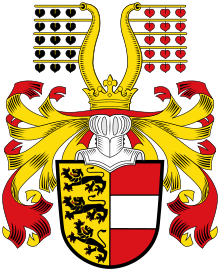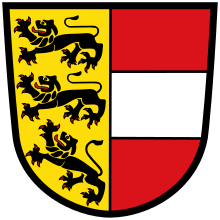Carinthian coat of arms
The coat of arms of Carinthia is loud State Constitutional Act of July 11, 1996, the Constitution was adopted for the province of Carinthia (Carinthian State Constitution - K-LVG), Article 6 (2)
- "[...] the historical coat of arms. The shield of the country's coat of arms is split in gold and red ; in front are three black, red-tongued and armed lions one above the other, behind a silver bar . The crowned Spangenhelm with red and gold covers has two golden buffalo horns, each with five golden sticks on the outside, three black linden leaves hanging down on the right and three red on the left . "
Modern blazon :
- “Split by gold and red, in front three striding red-tongued and armored black lions in stakes, behind a silver bar. On the crowned Spangenhelm with red and gold covers, two golden buffalo horns, each with five golden sticks on the outside, with three hanging black linden leaves on the right and three red linden leaves on the left. "
The Carinthian coat of arms is not crowned , like the other coats of arms of the old crown lands , but shown with a helmet and crest . Carinthia is the only federal state that officially has a large coat of arms - full coat of arms , with helmet, crest and helmet covers - and a small coat of arms - shield, as such on the state flag ( Vienna also has two variants).
The management, use and protection of coats of arms and seals are regulated in the law of June 19, 1985 for the protection of the Carinthian coat of arms and other emblems of the state of Carinthia (Carinthian coat of arms law, LGBl. 69/1985), which is based on the somewhat more liberal (federal) coat of arms law 1984 responded.
history
The coat of arms of the Duchy of Carinthia emerged in this form only after the Babenbergs died out in 1246 and was originally a claim coat of arms . Duke Ulrich III. was married to his widow in his first marriage and to a great niece of Duke Frederick II of Austria in his second marriage and on this basis raised claims to the Babenberg inheritance, which, however, became obsolete after the Duke's death in 1269.
The coat of arms shows the three lions of the Mödling side line of the Babenbergs as well as the Austrian shield . These lions are very similar to the three Hohenstaufen lions (as they appear again today in the coat of arms of Baden-Württemberg ). Staufer and Babenberger were so closely connected that they were considered one family at the time.
During the Habsburg era, especially when it was crown land , the coat of arms was occupied by the ducal hat .
In the 12th and 13th centuries, the Carinthian Sponheimers carried a black panther on silver (sable fur on ermine), apart from the colors very similar to the Styrian coat of arms . Whether this was also used as the Carinthian coat of arms is controversial. Due to the influence of Jožef Šavli , the figure caused a sensation as the Karantan panther from the 1980s onwards .
Margaret of Tyrol with the Carinthian coat of arms at her feet (oil painting 16th century)
Coat of arms of the Duchy of Carinthia during the Austro-Hungarian monarchy
literature
- Peter Diem: The symbols of Austria . Kremayr & Scheriau, Vienna 1995.



